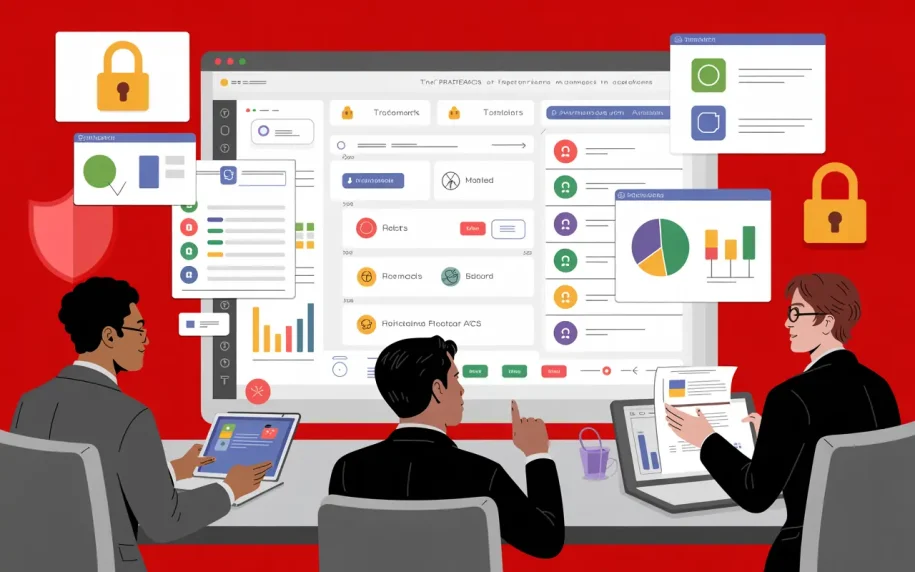Trademark and domain name portfolios have become strategic assets. For corporate legal departments and general counsel, managing these assets is no longer about “keeping an Excel file” or stacking reminders. The stakes are clear:
- Avoid costly oversights.
- Anticipate risks related to infringements and disputes.
- Demonstrate the value of intellectual property to top management.
Choosing trademark management software is therefore a fundamental decision. But how should it be evaluated? Here is an 8-step method, based on criteria that truly matter to in-house counsel and law firms.
Sommaire
- 1 Clarify your business objectives
- 2 Map your current portfolios and processes
- 3 Check deadline management
- 4 Examine data security and confidentiality
- 5 Test ease of use
- 6 Evaluate domain and document integration
- 7 Anticipate costs and added value
- 8 Make the decision
- 9 Conclusion
- 10 FAQ – Trademark Management Software
Clarify your business objectives
Before comparing solutions, define your priorities:
- Risk reduction: never miss a renewal or opposition deadline.
- Strategic steering: access clear reports for top management.
- Operational efficiency: save time by centralizing your data.
- Global vision: include not only trademarks but also domains and monitoring.
A good software doesn’t just store trademarks—it should help transform them into strategic assets.
Map your current portfolios and processes
Conduct an audit:
- How many trademarks do you manage, across how many countries and classes?
- Which domain names are linked to your trademarks?
- How do you currently track deadlines (renewals, oppositions, affidavits)?
- Where are documents stored (contracts, proof of use, correspondence)?
This mapping allows you to compare your real needs with the features offered.
Check deadline management
Deadlines are the lifeblood of trademark management. Reliable software must:
- Automatically generate renewal deadlines based on offices.
- Centralize them in a single calendar.
- Send automated reminders.
- Allow filtering and prioritization by urgency, country, or client.
- Track all actions (creation, modification, validation).
The objective: achieve “zero missed deadlines” through robust consolidation and automation.
Examine data security and confidentiality
Trademark portfolios are strategic assets; their security is non-negotiable. Software should provide:
- Hosting compliant with European standards (GDPR).
- Data encryption (at rest and in transit).
- Frequent backups across multiple sites.
- Full access and modification traceability.
- 24/7 monitoring and an incident recovery plan.
Always ask for written proof or clear technical documentation.
Test ease of use
Powerful but complex software is counterproductive. Legal teams look for:
- An intuitive, customizable dashboard.
- Multi-criteria search to quickly find a trademark or domain.
- Visual status indicators (color codes, labels) for instant clarity.
- Smooth document management (templates, versions, organization).
Rule of thumb: if you need hours of training to perform a simple search, the tool isn’t right.
Evaluate domain and document integration
Trademark management doesn’t stop at registries. It should also include:
- Domain monitoring (availability checks, TLD tracking, DNS management).
- Connections between trademarks and domains to prevent inconsistencies.
- Centralized management of related documents (contracts, proofs, invoices).
The more integrated the tool, the less risk of fragmentation and duplicate systems.
Anticipate costs and added value
The sticker price isn’t enough. Assess the Total Cost of Ownership (TCO):
- Subscription fees.
- Data migration.
- Training and support.
- Optional modules (billing, enhanced monitoring).
But also consider the added value:
- How much time saved in research and reporting?
- How many risks avoided (a missed renewal can cost more than a year’s license)?
- How much clarity gained for steering intangible assets?
The real cost of software is what it saves you and how it enhances your portfolio’s value.
Make the decision
At this stage, ask:
- Does this software truly reduce my risks?
- Does it provide a clear, actionable view of my portfolio?
- Can it evolve with my brands and territories in 3 to 5 years?
Choosing software is not just buying a platform—it’s investing in the sustainability and competitiveness of your intangible assets.
Conclusion
Managing trademarks and domains is no longer an administrative task—it’s a strategic challenge requiring rigor, anticipation, and visibility.
The right management software helps you:
- Secure deadlines.
- Centralize data.
- Save time.
- Demonstrate the value of intangible assets to management.
These 8 steps provide a clear framework to evaluate solutions and identify the one that will turn your portfolio into a true driver of competitiveness.
FAQ – Trademark Management Software
- Can an Excel spreadsheet be enough to manage a trademark portfolio?
No. Excel cannot automatically generate deadlines or guarantee traceability and security. It’s risky. - Do software solutions include domain name management?
Some do, like IPzen, which offers a dedicated module (TLD monitoring, DNS, renewals). This is a differentiating factor. - How long does it take to deploy trademark management software?
It depends on portfolio size. With a well-prepared migration and an intuitive tool, onboarding can be fast (days to weeks). - Are these tools only for large firms?
No. In-house legal teams and mid-sized firms also use them. Most solutions are modular. - What benefits can I present to management to justify the investment?
- Reduced risk of missed deadlines.
- Operational time savings.
- Better strategic visibility.
- Enhanced valuation of the IP portfolio.


